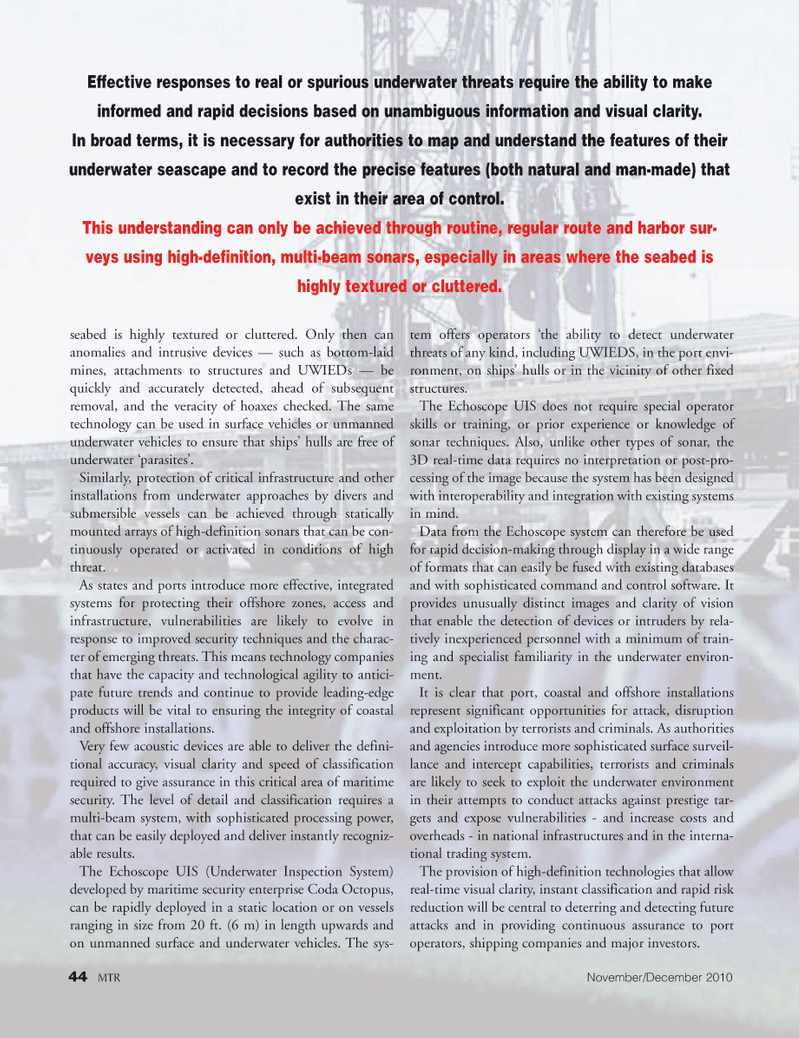
Page 44: of Marine Technology Magazine (November 2010)
Fresh Water Monitoring and Sensors(lakes, rivers, reservoirs)
Read this page in Pdf, Flash or Html5 edition of November 2010 Marine Technology Magazine
44 MTR November/December 2010 seabed is highly textured or cluttered. Only then can anomalies and intrusive devices — such as bottom-laid mines, attachments to structures and UWIEDs — be quickly and accurately detected, ahead of subsequent removal, and the veracity of hoaxes checked. The same technology can be used in surface vehicles or unmanned underwater vehicles to ensure that ships’ hulls are free of underwater ‘parasites’.
Similarly, protection of critical infrastructure and other installations from underwater approaches by divers and submersible vessels can be achieved through statically mounted arrays of high-definition sonars that can be con- tinuously operated or activated in conditions of high threat.
As states and ports introduce more effective, integrated systems for protecting their offshore zones, access and infrastructure, vulnerabilities are likely to evolve in response to improved security techniques and the charac- ter of emerging threats. This means technology companies that have the capacity and technological agility to antici- pate future trends and continue to provide leading-edge products will be vital to ensuring the integrity of coastal and offshore installations.
Very few acoustic devices are able to deliver the defini- tional accuracy, visual clarity and speed of classification required to give assurance in this critical area of maritime security. The level of detail and classification requires a multi-beam system, with sophisticated processing power, that can be easily deployed and deliver instantly recogniz- able results.
The Echoscope UIS (Underwater Inspection System) developed by maritime security enterprise Coda Octopus, can be rapidly deployed in a static location or on vessels ranging in size from 20 ft. (6 m) in length upwards and on unmanned surface and underwater vehicles. The sys- tem offers operators ‘the ability to detect underwater threats of any kind, including UWIEDS, in the port envi- ronment, on ships’ hulls or in the vicinity of other fixed structures.
The Echoscope UIS does not require special operator skills or training, or prior experience or knowledge of sonar techniques. Also, unlike other types of sonar, the 3D real-time data requires no interpretation or post-pro- cessing of the image because the system has been designed with interoperability and integration with existing systems in mind.
Data from the Echoscope system can therefore be used for rapid decision-making through display in a wide range of formats that can easily be fused with existing databases and with sophisticated command and control software. It provides unusually distinct images and clarity of vision that enable the detection of devices or intruders by rela- tively inexperienced personnel with a minimum of train- ing and specialist familiarity in the underwater environ- ment.
It is clear that port, coastal and offshore installations represent significant opportunities for attack, disruption and exploitation by terrorists and criminals. As authorities and agencies introduce more sophisticated surface surveil- lance and intercept capabilities, terrorists and criminals are likely to seek to exploit the underwater environment in their attempts to conduct attacks against prestige tar- gets and expose vulnerabilities - and increase costs and overheads - in national infrastructures and in the interna- tional trading system.
The provision of high-definition technologies that allow real-time visual clarity, instant classification and rapid risk reduction will be central to deterring and detecting future attacks and in providing continuous assurance to port operators, shipping companies and major investors.
Effective responses to real or spurious underwater threats require the ability to make informed and rapid decisions based on unambiguous information and visual clarity.
In broad terms, it is necessary for authorities to map and understand the features of their underwater seascape and to record the precise features (both natural and man-made) that exist in their area of control.
This understanding can only be achieved through routine, regular route and harbor sur- veys using high-definition, multi-beam sonars, especially in areas where the seabed is highly textured or cluttered.

 43
43

 45
45
